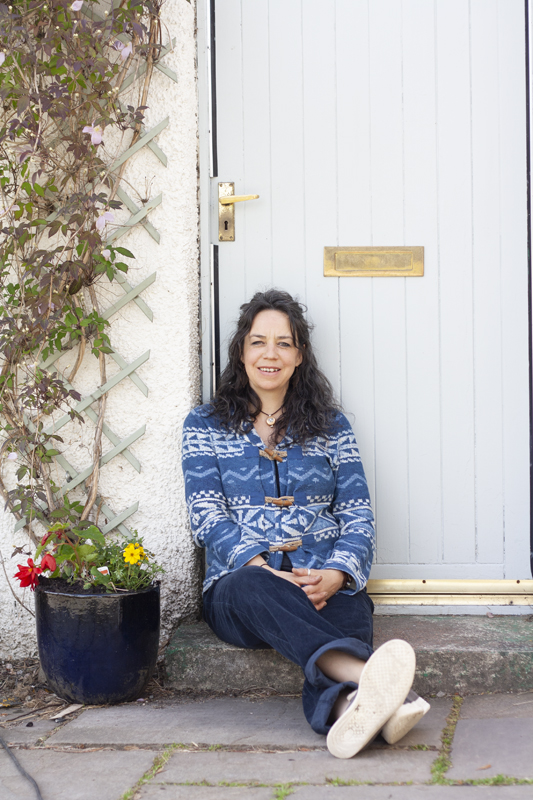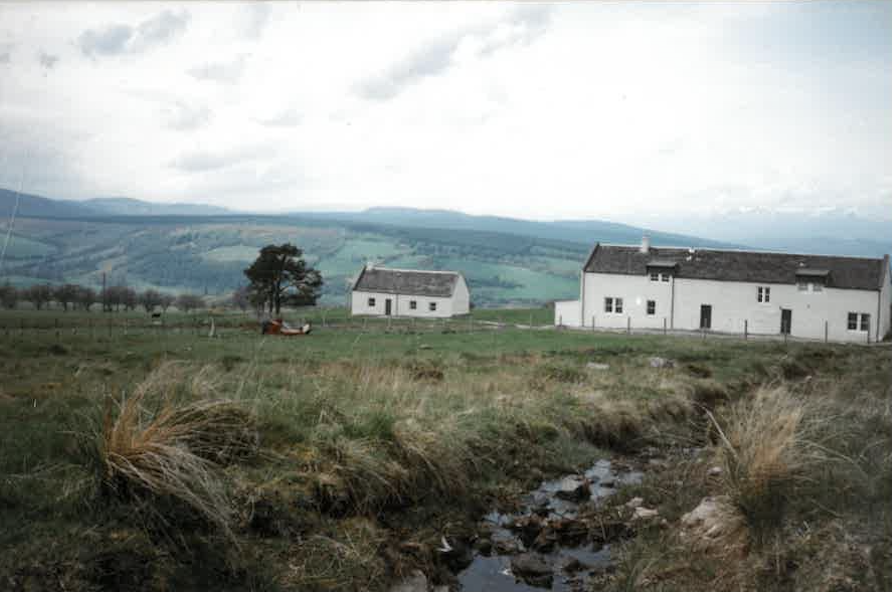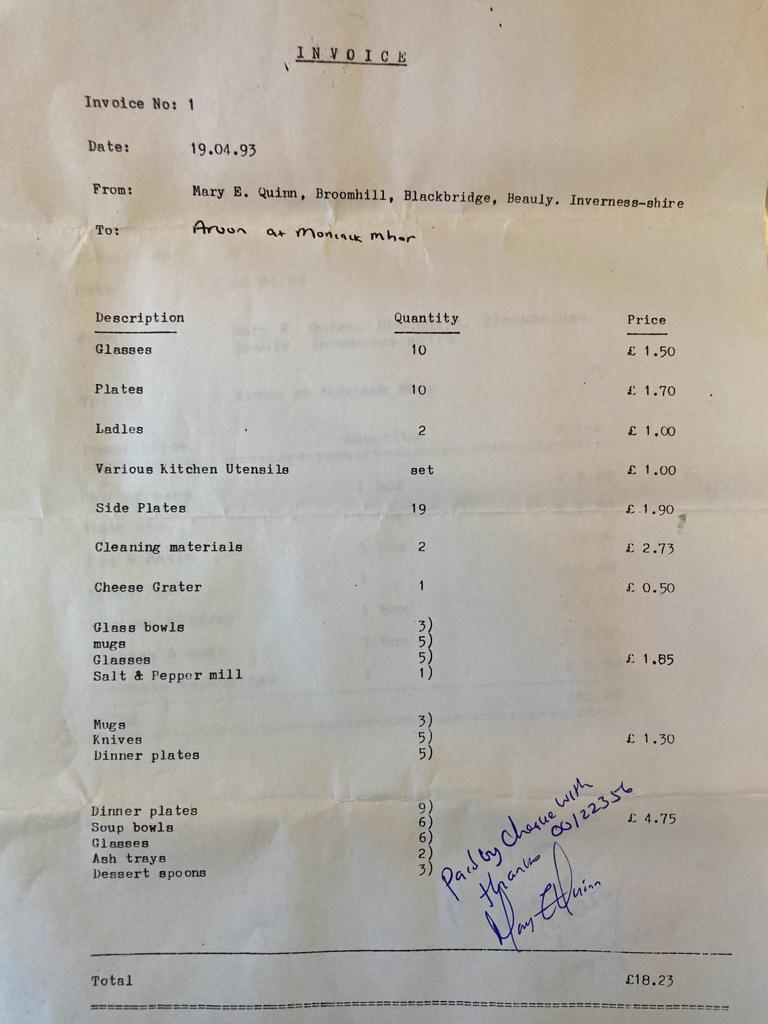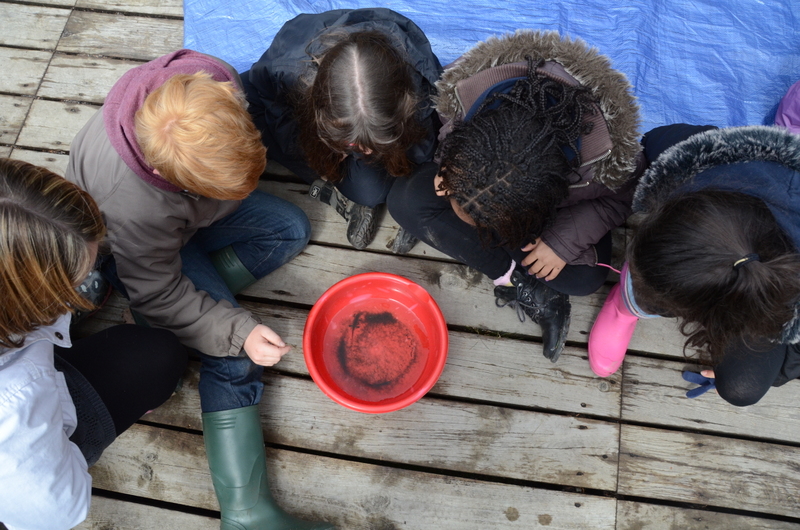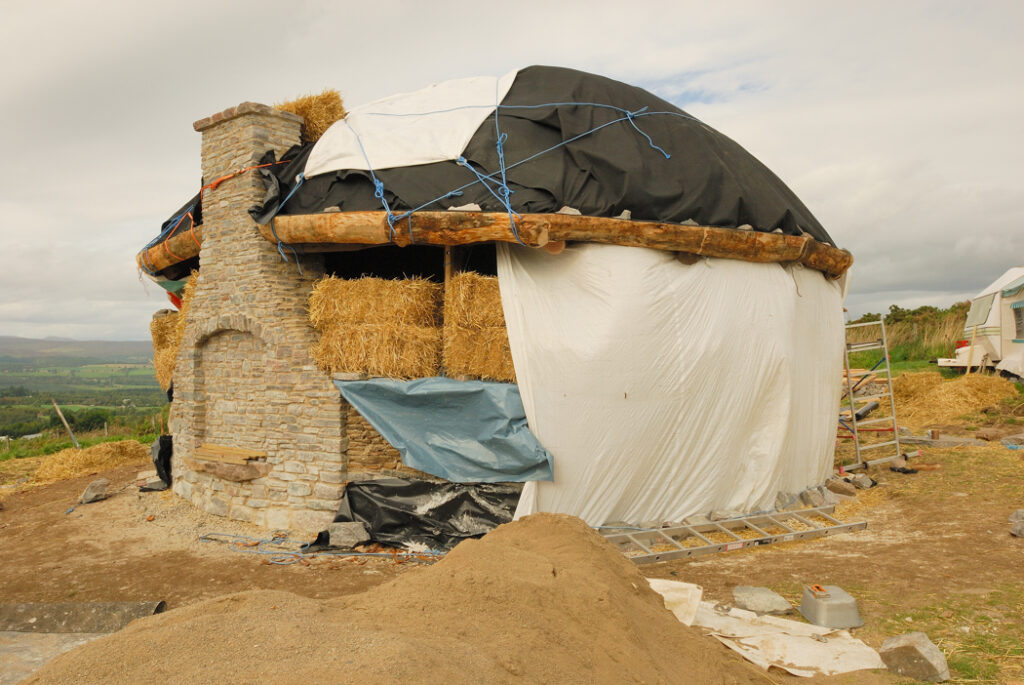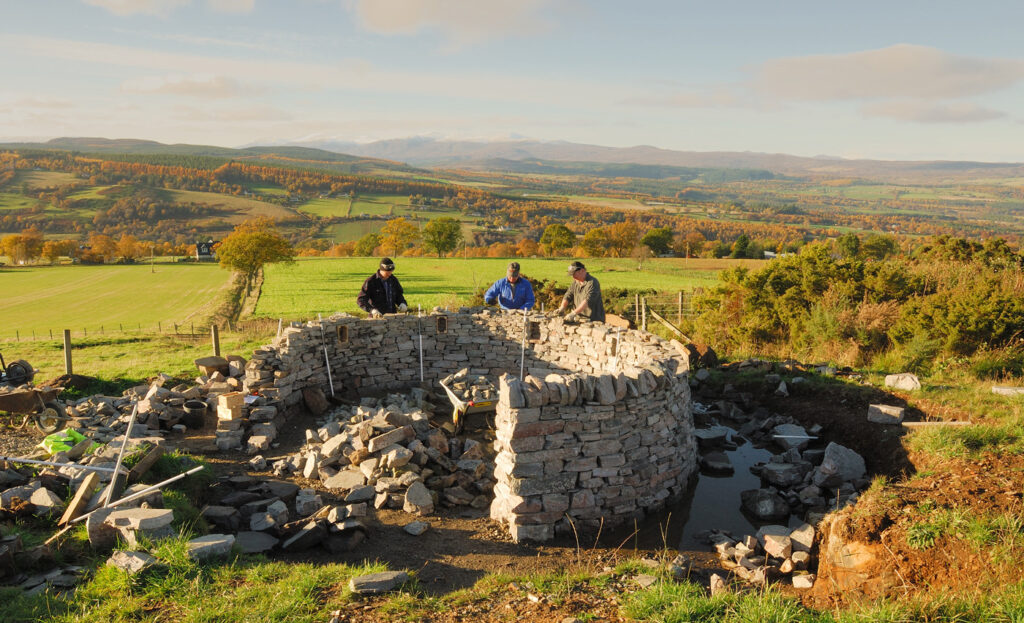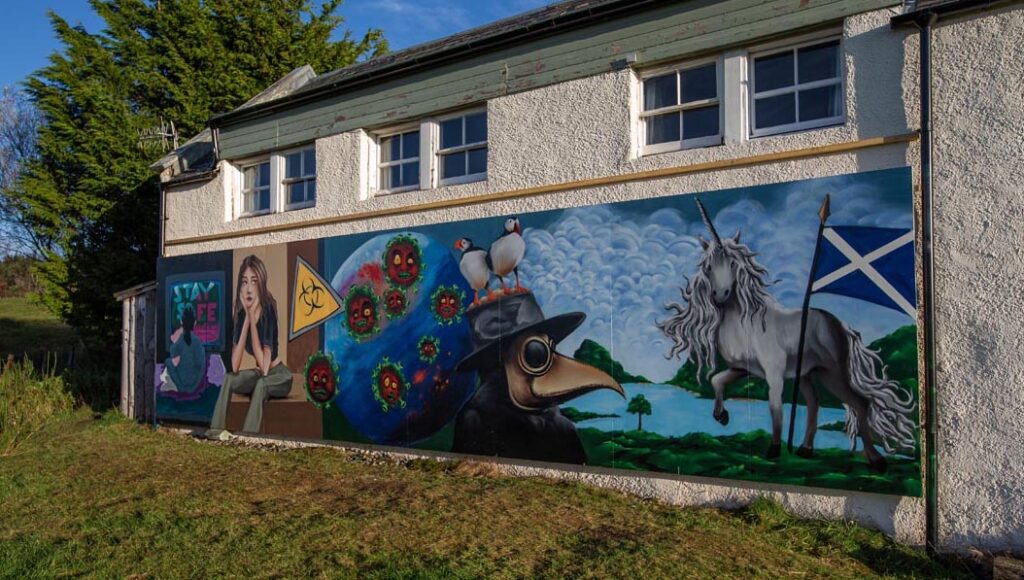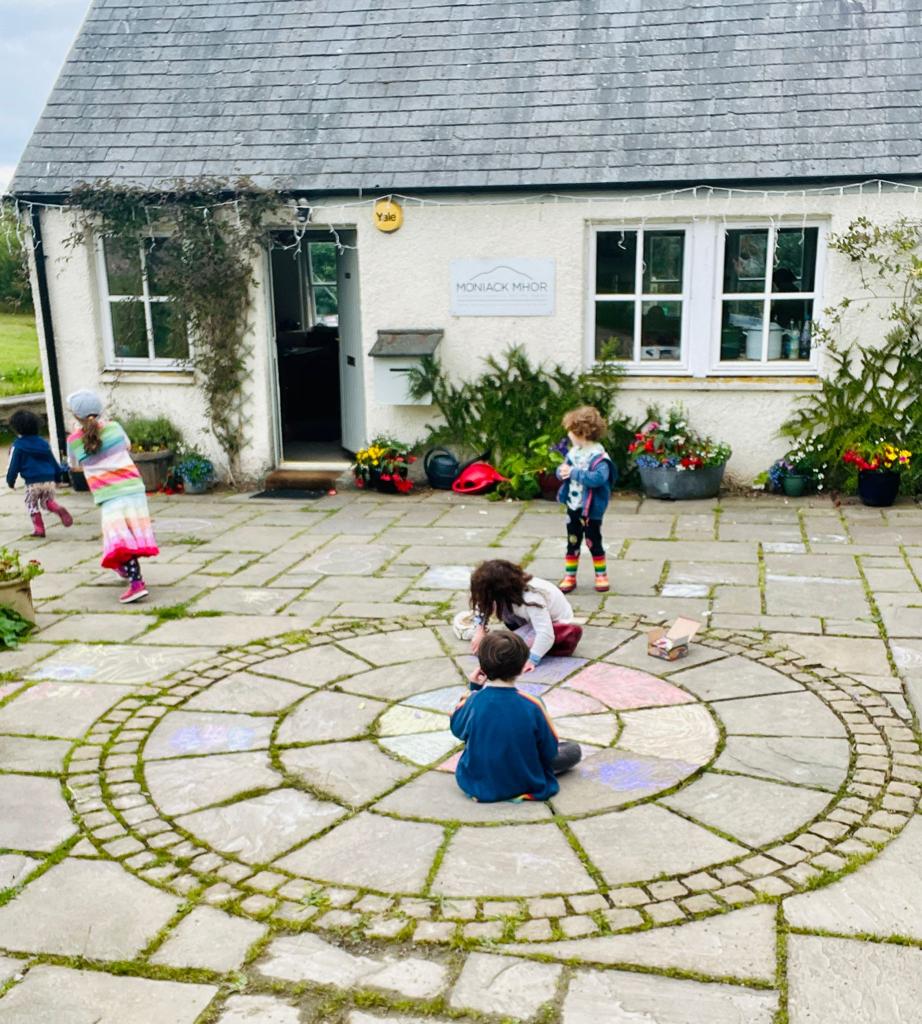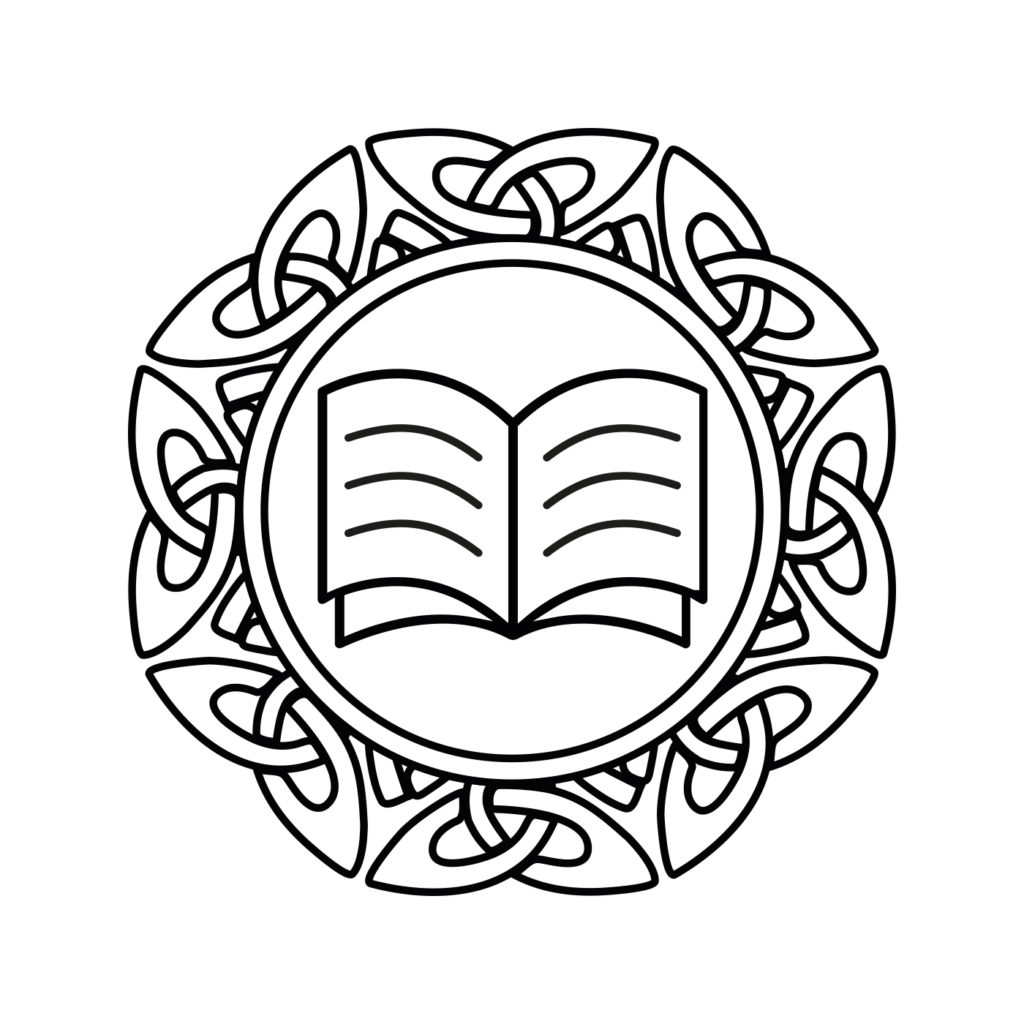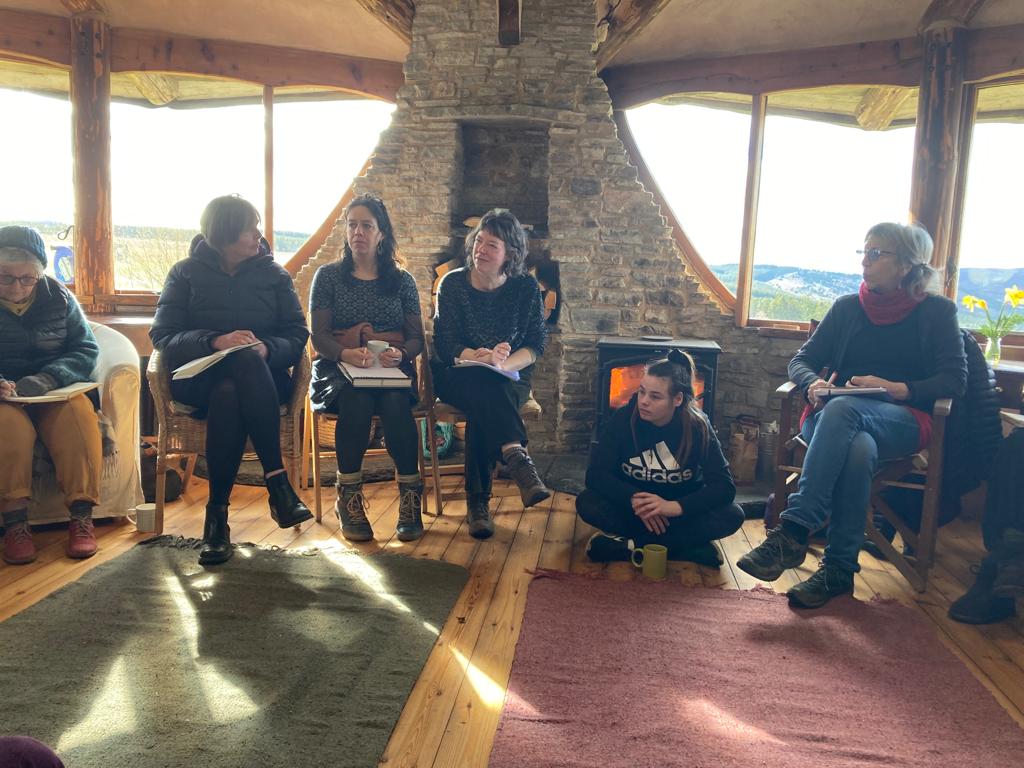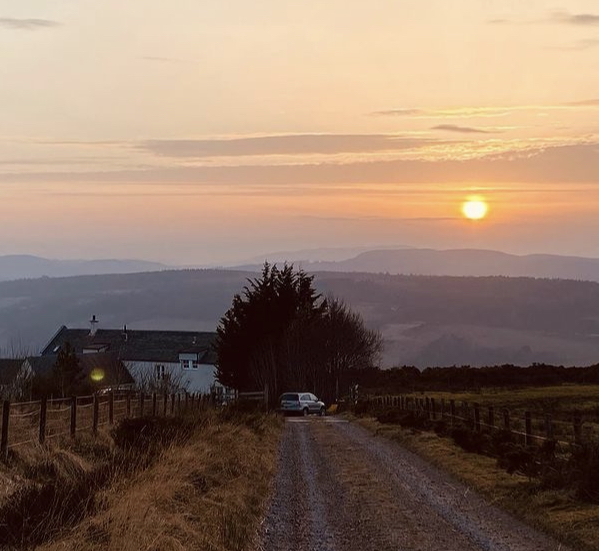Welcome to Moniack Mhor, 30 years of words and hospitality…
Today, Wednesday 17th May 2023, marks thirty years since Moniack Mhor opened its doors to writers. We are delighted to relaunch the Moniack Mhor Blog with reflections on this big birthday from Rachel Humphries, our Centre Director. And look out for more reflections, memories, and anecdotes appearing on the website and on our social media channels over the course of the year, as well as news of special courses and events.
It’s thirty years since Moniack Mhor opened its doors. I’ve been here for only twelve of those and, on the eve of our 30th birthday whilst ruminating from my home, I think about its essence. Why doesn’t Moniack feel like a job? Why does it lift my spirits every day when I drive along the road and turn down the track, past our little sign to the familiar hearth and home of Moniack Mhor? Why does it feel like a safe place to be creative? I think it’s down to the people that inhabit the space; yes, the views are lovely and it’s an environment conducive to writing, but it’s the optimism of those that dive into the creative process every day that makes it work. Week on week a fresh worship of writers comes through the doors, every week is different, but every week is full of quiet, humble hope. And it is collective, like passing the baton from one small tribe to another. I recognise what has been created here over the years is through kindness and a commitment to the craft. It is with this at the fore that I cast my mind back over my time at Moniack and try and do justice to the years before.
In 1993, we hosted our first course. Once a working croft with cattle barn and cottage, the buildings fell into disrepair in the 60s, until it was discovered by Kit and Sophia Fraser in 1991. The land was crofted by the MacDonald family and Teenie Matheson, the lady that lived in the cottage who had a thriving garden of soft fruits. So much so that the local kids who delivered her milk could fill her bloomers on the washing line with gooseberries. If only we could talk to her now! Kit and Sophia had a dream, and that dream was to gather writers and make new work in this rare space. After a 24-hour fundraising poethon, lots of letters to trusts and foundations, nearly two years of restoration, and many invites to novelists, poets, playwrights and many more, the centre began its new life as a creative hub for writers.
Going back in time
So come on a journey to 1993: crofting tales linger but now the smell of paint is fresh in the air, the final pictures are being hung on stone walls and there is frantic unpacking of auction house crockery and cutlery. We welcome our first course, led by Liz Lochead, Roger McGough and the late Aonghas MacNeacail. The nervousness soon melts away as words and wine flow and, day after day, new work is created. And what a year that must have been. Our first Poetry course was quickly followed by Short Story with the late Carl MacDougall and Dilys Rose, then Fiction with Jim Kelman, Alan Spence and Agnes Owens and a second poetry course led by Carol Ann Duffy, Jackie Kay and Edwin Morgan. We were visited by Janice Galloway and AL Kennedy who spent their week nurturing novel writers, followed by tutors, Iain Crichton Smith and Stewart Conn. These are Moniack Mhor’s real foundations. None of this would have worked if it wasn’t for the commitment of the team in the early days: Kit, Sophia, Chris, Margaret, Nicky, Anne, Catriona, Cynthia, Lyndy, and all of the other folk that devoted their time and energy into making it a success. It goes without saying that the fundamental relationship was with the Arvon Foundation and we are thankful for the openness of their founders, John Moat, David Peas, Ted Hughes, and John Fairfax, when they stretched their vision to the Highlands. It brought us into contact with amazing writers and taught us how to create that magic formula that can be instrumental in shifting the beginnings of a story or poem into something that will be immortalised.
After a short stint at Moniack Mhor in 2006, I was lucky enough to join the organisation properly in 2010. I was welcomed by wonderful colleagues, Cynthia Rogerson and Lyndy Batty, both of whom had been with Moniack Mhor for a good number of years, and they set the tone and the bar high. Warm, nurturing, genuine, and creative. For me, Cynthia and Lyndy were the backbone of Moniack and I am ever grateful to them for their straightforward, energetic approach to everything. Not a day went by when Lyndy didn’t transfigure into something or someone else in the office, from a llama down the road, to the coal person to a garish rucksack carried by a tutor! Always done with fun and kindness. It took years to learn the ropes, literally, longer than any human being should be allowed. I’d worked for the Children and Families department of Social Work, a school, a youth hostel, for a music company, an old folk’s home and been at university, but nothing compared to Moniack – the effort at first felt mythical, it was like trying to stuff an octopus into a very small wardrobe! My predecessor, the brilliant writer Hamish Macdonald, with a clear look of relief on his face, handed me a simple green file marked ‘Septic Tank’… this is not what I had expected to be dealing with on day one. But it was magical (apart from the septic tank). Every day I was blown away by the optimism, electricity, and altruism that I experienced from tutors, guests, and visiting writers. Very soon after joining the team, it felt like home, and I loved the challenge and could see the good in everything it did.
Early projects
I know of some of the projects that took place before I arrived, but I don’t pretend to know them all. After these early years, there have been some more significant events in the life of Moniack Mhor. Our residency experience began in 2001 with Writers Across Frontiers, a partnership with Scottish PEN which was attended by Kurdish poet Choman Hardi. Hamish, Centre Director at the time, also established the Jessie Kesson Fellowship, with the blessing of the writer’s daughter, Alva. Its aim was to celebrate the writer’s inspirational life and work. In 2009, its inaugural resident was Suchen Christine Lim from Singapore. This award has gone from strength to strength and in 2016, we saw the centenary of Jessie Kesson’s birth, which we celebrated with a ceilidh in the Abriachan hall attended by Jessie Kesson’s daughter, her granddaughter, and her great granddaughter. To date, this award has been held by a wide variety of established writers including, but not limited to, Donald S Murray, Joan Lennon, Daniel Shand, Ryan van Winkle, Claire Askew, Sean Burns, and Debris Stevenson. Our 2023 Jessie Kesson Fellow is Genevieve Carver. In 2009, the centre ran a project with Dark Skies and the Royal Observatory which saw advanced higher pupils spending the week stargazing and working with poets Gerry Cambridge and Magi Gibson, producing poems for posters with NASA images from space. It was the same year that the Written World project, in association with the Abriachan Forest Trust, was offered to primary school pupils in the local area. The project saw them working in the forest in the morning, burn dipping, planting trees, and doing a whole range of other outdoor activities before joining us at Moniack in the afternoon for nature writing. That’s all just a small snapshot of the time before I joined the organisation.
In my time, significant developments started in 2013 when the garden was awash with bell tents, hand tools and music, and a year later our lovely Straw Bale Studio was born, the offspring of the talented envisioneer, Steve James. The room was designed to be two small sitting room tutorial spaces separated by a collapsible wall. Of course, we got too ambitious, and it didn’t work! Nearly ten years later we remain thankful that wall didn’t work and that we have this fabulous space for readings and workshops. We learned later that this is one of a kind, being the only double reciprocal roofed structure in Europe that we know of. In that same year, at the weekends we were joined by the local community who helped us develop the garden as part of the Beechgrove Garden Community Garden scheme. Garden designer, Kirsty McLean, presenters Jim and George, and the production team arrived on site and the garden was transformed in but a few days. The talented, Alastair Simmons, our gardener at the time, worked with the Beechgrove team to envisage an infrastructure that encouraged writers to use the outdoor spaces.
Under the leadership of George Gunn, master drystone waller, and 12 volunteers, the story circle was built. This project taught me a lot, I never imagined that I would be able to eyeball a pile of sub-base and say ’20 tons’ in a confident tone, and freely use words like ‘whacker plate’ and ‘self-binding gravel’. We delivered a number of community garden workshops throughout that period, including growing in a polytunnel, encouraging wildlife into your garden, and yoga and writing workshops. The energy poured in by many people feels tangible to this day. Our thanks go out to the community for supporting us through this time.
Independence
During this whirlwind of physical developments were other significant changes. We were to move away from the Arvon Foundation (now Arvon), our partner of 23 years. It was a bold, terrifying, but exciting step in our lives. Moniack’s partnership and other activity had developed significantly, and it was time to seize creative freedom and begin to schedule courses under an independent banner. With a mailing list of less than 100 people, we moved forward with trepidation, sometimes with fear and always with a buzz, to start ‘Turning the Page’, a project that shaped the model today. Our thanks go to Creative Scotland for supporting this transition through the Cultural Economy programme and to the wonderful team that weathered the storm, Cynthia, Lyndy, Sarah, Ruth, and Mark. I think fondly back to 2010, when I was interviewed by the late Gavin Wallace. He asked me ‘where could I see Moniack in ten years?’, and I replied, ‘perhaps doing its own thing and running a bigger programme that opens things up for more writers’. With a sparkle in his eye, he said something along the lines of ‘Now that is something I would very much like to see!’. I wish Gavin was with us now to see what we are doing. In that year of major change, we had such careful and considered support from the literature team at Creative Scotland, Emma, and more latterly, Jenny and Aly who put so much time aside to provide Moniack centred advice and encouragement. By 2018, we were able to breathe, reflect, and to fully embrace Moniack as its own entity.
Young writers at Moniack Mhor
I touched on this earlier, but I’d like to return to our work with young people. Moniack Mhor has always strived to nurture the skills of young writers and they have engaged with Moniack Mhor in varied and inspiring ways. We were privileged to host the Pushkin Prize Winners annually for many years, an international award that saw young Russian writers working alongside Scottish peers. This project ran until 2019 and we are grateful to Lindsay Fraser and Katherine Ross for facilitating this brilliant initiative. We have been working with secondary schools now for over twenty years, offering tuition and support to young people from the local area, nationally, and internationally, including supporting young people from Canada through Centauri Arts Academy. We delivered the Highland Young Writers Award as part of ‘Time to Shine’ which saw seven young people gain mentoring for their work over a year, and ran a Highland Young Writers’ Conference in Inverness which was attended by over 150 young people. Moving on, Eilidh Smith, our Youth Programme Manager worked with Gerry Cambridge and a group of young editors to create the ‘Tide that Turned in Spring’, an anthology of young Highland writing. We began our work with care experienced young people as a Cashback for Creativity partner and went on to gain funding from the Life Changes Trust, running residential weeks, workshops, mentoring, and nurturing creative development through grants for over 200 young care experienced people in Scotland. Young people made music, created a 10-metre long mural on the back of the building, wrote a play, and built friendships with one another. Our work continues to expand with our Creativity and Care programme, which aims to connect young people who have lived experience of the care system throughout Scotland and further afield through multi arts opportunities.
Going international
Over the last few years, we’ve developed our international work. In 2019, we were joined by poet, Lagos International Poetry Festival director and all round brilliant being, Efe Paul Azino, for our Muriel Spark residency which was supported by the British Council. Efe was joined by poet, singer songwriter, and playwright, Rodney DeCroo from Canada. It was the steppingstone to what came next. ‘Connect and Collaborate’ in 2021 saw writers from India, Canada, Spain, West Africa, and Scotland stay with us for a month, undertake a small tour of the Highlands (which included a late-night rendition of Abba in a pub in Ullapool and going to bed at 4am) and deliver community workshops. Alongside, we emerged from a global pandemic, connecting these energies from around the world, at a time when our relationships were more fragmented than ever. This left an indelible print on the organisation and fuelled our desire to create similar opportunities. For me, it’s been some of the most influential learning experiences in my time at Moniack Mhor. ‘Here and Now’, our international programme, will build upon this by integrating a reciprocal residency with the Library Of Africa and The African Diaspora in Ghana in September, after a month at Moniack in July/August, culminating in performances at the Lagos International Poetry Festival.
Making Moniack accessible
The pandemic was tough, as it was for many of us. We closed for eighteen months and lost members of our team. But some good came of it. Our Online Programme is going from strength to strength. We are working critically and honestly to reflect on what works, what writers need, and how we can deliver this. It’s opened the programme up in terms of supporting people all over the world and has broken down barriers for people who can’t attend a residential course. Our Made to Measure Mentoring scheme is a new addition too, after many years of consideration. It has supported around 70 writers since its inception in February 2020, many of those with multiple sessions. It allows us to have a longer relationship with writers that visit us and help writing projects come to fruition. Access is the central pillar in our work. Our bursary scheme, supported by Friends of Moniack Mhor (our deep gratitude goes to everyone who is a member of this scheme) enables around 50 writers a year to participate in our programme. Our Radical Care residencies last year provided time and space for professional and emerging writers to immerse themselves in their work whilst their children were supported by our neighbours at Abriachan Forest School.
The Highland Book Prize
In 2016, we joined forces with the Highland Society of London and the Ullapool Book Festival to create the Highland Book Prize, a prize that celebrates the finest published work that recognises the rich talent, landscape and cultural diversity of the Highlands. Since we launched it, I’ve thought about the process and how it’s been received, running a book prize presents its own challenges. How do we present this and remain close to our ethos? How do we host a prize that is open to fiction, poetry, non-fiction and work in English and Gaelic? For us, it is vast – with 80 plus submissions it makes for quite a task each year. Perhaps the model we work with supports this. With a volunteer panel of over 100 readers, a longlist series that showcases all titles in the first judging stage, and constant reflection on the process and a rotating judging panel of excellent individuals, we aim to run a community prize. It brings us all the closer to writers and, for me, shines a much-needed light on what is going on up in the Highlands in terms of literary achievements, of which there are many. It’s very much worth it!
A creative space
Working at Moniack Mhor is never a job, Moniack wouldn’t let it be a job, it’s a lifestyle, it’s busy but it’s creative. We have lots of projects underway or in the pipeline. We were recently visited by a friend and artist, Helen Dennerly, who worked with Jen Hadfield to create new haiku and short form poetry that will be included in a scrap metal sphere as part of Helen’s next exhibition at Kilmorack Gallery. We have just become the custodians of our dear friend, Janice Galloway’s library as she retires from writing. It is an honour to keep these precious books safe for Janice and very soon we’ll be opening the library for all to use. We’re about to deliver our new songwriting project, Stages: A writing, production and performance programme with Boo Hewerdine. Boo has been sharing his wisdom with Moniack for many years now, and we’ve had so many ideas together, it’s time to turn these into something more concrete that provides holistic learning about the songwriting industry. We run a local writing café in Inverness for young people, inviting our guest readers to join us for an extra night to teach. We provide space at the centre for two local writing groups, with one group purely for poets. Turning to awards, we are partnering on the Jenny Brown Associates over 50 Award, the Caledonian Novel Award and the International Book and Pamphlet Competition run by the Poetry Business. Our residency scheme continues to expand, and this summer, we are offering a month-long residency, alongside our Here and Now project for a Ukrainian poet and arts leader, Ostap Slyvynksy, and a residency for non-binary and trans writers next year, alongside delivering a spring residency for professional writers. We have lots more ideas wrapped around the residency model, including running a small, young writers festival in Inverness as part of a resident engagement programme. Listening and dreaming are a potent cocktail and I look forward to working with the team on more inventive ideas going forward.
What’s next?
So, what might be in store for us over the next ten years? We don’t want to change who we are, but we want to keep developing our artistic and practical aspects. We are working on a feasibility study to alter the building to provide more accessible rooms and bathrooms, a bigger office for our team (maybe even with our own loo!), a year-round residency space and a learning room/library. We’ll work with access experts to enhance what we can. We’ll continue to look at the environmental impact of our organisation and what aspects of our garden can we expand. We’d like to explore course models, perhaps designing longer courses or retreats or blended face-to-face and online opportunities. We would like to look at what we can offer and experiment with new genres that open us up to more people. We’d like to strengthen links between international writing communities to allow for more cross-cultural learning and apply this to international youth communities. But, for the most part we will keep doing what we do, allowing birdsong to sing in quiet spaces during workshops, encouraging writers, and working with some of the finest tutors around.
I like to think that Moniack Mhor will continue to nurture quieter voices in literature, to hear from those with lived experiences by making our programme accessible to all. Often, I think of a long feasting table full of people of all ages and from all types of backgrounds. Maybe it’s too idealistic, but my hunch is that it’s not! I’ve seen many glimmers of this in the past and I think only through gentle striving can it be a reality. Moniack Mhor has been built by friends, and my sincere thanks go to all of the people, past and present, no matter how big or how small their contribution was and is. Of course, a special mention must go to our board and the whole of the Moniack team for their endless energy, creativity, and care. I consider myself very lucky to be part of a team that ignores barriers, turning them into solutions. Thanks to Claire, Ange, Kirsteen, Marina, Ellen, Kit, Pauline, Isobel, Carolyne, Jon, Charlotte, Vicky, and Matt for everything they do. I will leave now with a poem by one of our patrons, Carol Ann Duffy that does more justice to us than I can!
Moniack Mhor
Something is dealing from a deck of cards,
face up, seven, a week of mornings, today’s
revealing the hills at Moniack Mhor, shrugging off
their mists. A sheepdog barks six fields away;
I see the farm from here.
Twelve-month cards, each one thumbed, flipped,
weathered in its way – this the eighth, harvest time,
a full moon like a trump, a magic trick.
It rose last night above this house, affirmative.
I sensed your answer – hearts.
Or a single hour is a smiling Jack, a diamond,
or a spade learning a grave; charms or dark lessons.
Something is shuffling; the soft breath of Moniack Mhor
on the edge of utterance, I know it, the verbs of swifts
riffling the air
and the road turning itself into the loch, a huge ace
into which everything folds. Here is the evening,
displayed then dropped to drift to the blazon of barley, bracken,
heather. Something is gifting this great gold gathering of cloud;
a continual farewell.
Carol Ann Duffy





